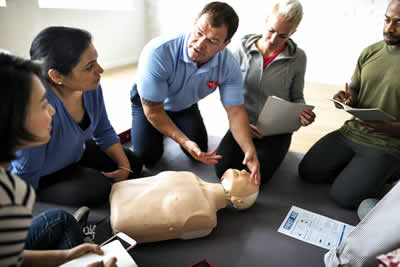We’re not exaggerating when we say that across the board, it’s a tragedy that personal growth within people’s jobs is rarely attended to. Or if it is, it’s often as an afterthought … almost a throwaway.
Well, personal growth in the workplace is more than just a concept: it's central to keeping people engaged in their jobs. If you’re a manager, and you develop a team ethos that encourages continuous learning and development, you’ll build a motivated and dynamic team.

You can allocate challenging projects, welcome constructive feedback, and introduce training programs. And by doing this, you’ll create a workplace where employees thrive. And you’ll reap the rewards.
So how do you do it? Here are some ideas that will set you up for success!
Promoting a Growth Mindset
This will transform your team's approach to their work. There are fundamental differences between “growth” and “fixed” mindsets, and if you implement a few targeted strategies, you’ll create a working environment that’s positive and productive.
Understanding “Growth” vs “Fixed” mindset
There are real differences between these mindsets, which have a big effect on how people view their work.
With a growth mindset, people believe that their abilities and intelligence can be developed with effort and dedication. They see challenges as opportunities to grow, not obstacles to avoid. And when they think in this way, even the mistakes people make become valuable learning experiences!
On the other hand, with a fixed mindset, people believe that abilities are static, even unchangeable. They’ll shy away from challenges in case they fail; they prefer to stick to jobs they’re familiar with. With such a negative attitude, it’s no wonder that they actually limit their own growth.
We all have tendencies of both mindsets within ourselves, so first, you need to recognize this. Any manager who does this is then able to actively shift their team towards a more positive approach to their own growth and development.
Strategies for encouraging a growth mindset
It all starts with language. Praise the process and the effort people put in, not just the outcome. So for example, highlight the persistence of your team members in difficult situations, rather than only their successes.
Promote a learning culture by providing regular opportunities for skills development. Workshops, mentorship programs, and continuous feedback sessions are great ways to keep your team engaged … and focused on improvement.
Encourage risk-taking and creative problem-solving by making it acceptable to experiment (within reason, of course!) Properly controlled, this shows that failure isn’t punished, but seen as a way to improve. Reflecting on both successes and failures alike is a healthy way to be.
Creating a Supportive Environment
A
supportive environment is of course essential. This is achieved through strong leadership, peer support, mentorship, and a recognition and rewards system.
The role of leadership
Effective leadership sets the tone. Leaders who are approachable and empathetic create a positive work culture. Clear communication ensures everyone is on the same page, while regular feedback helps employees grow in their roles.
Leaders must be role models, too. When they show commitment to personal growth, their team members are highly likely to follow suit.
It’s also necessary to allow people to voice their concerns and ideas without fear of retribution! This is called “open dialogue”: it helps build trust as well as a team-based environment. And problems that may lie unseen until an explosion in the future can be discovered and fixed early on.
Peer support and mentorship
Peer support and mentorship can dramatically improve personal growth. people who share their knowledge and experiences actually create their own network of support. This kind of mutual assistance boosts morale and encourages learning.

You can introduce mentorship programs - both structured and informal. For example, pairing less experienced employees with seasoned colleagues gives them guidance for their development.
Group projects and team-building activities will build a sense of camaraderie. And when employees feel connected and supported by their peers, they’re more likely to thrive.
Recognition and rewards
Recognition and rewards also promote a supportive environment. When people’s accomplishments are acknowledged, they are motivated and think positively. It doesn’t need to be extravagant: just a simple "thank you" often works wonders!
Develop a system that aligns rewards with company values and goals. This way, you’ll make sure that recognition is meaningful. Money-based incentives are good, but other options include extra vacation days or more development opportunities.
And you must personalize recognition! This means you need to understand what motivates each employee so you can tailor rewards to what resonates with them. This personalized approach will increase their appreciation and loyalty. Make recognition a regular practice. Celebrate small victories along the way, not just the “big wins”. By doing this, you’ll encourage even more effort in the future!
Investing in Development Opportunities
Investing in people’s development helps them to improve their skills and knowledge, which paves the way for career advancement. There are several different ways to do this.
Training and workshops
Training and workshops provide hands-on experience and practical skills, and often focus on specific areas. Although it’s, technically speaking, “on the job” training, it’s often a good idea to take them out of the workplace – if only for a day or half-day session. And if you’re worried about finding a venue, you could use
serviced office spaces for these sessions.

These out-of-office environments create a relaxed and enjoyable atmosphere; they reduce pressure and make it easier for people to learn.
Doing this will significantly boost confidence and expand attendees’ skills. And if you use external trainers or experts, the chance to interact with them in a different setting accelerates and amplifies learning.
Career pathing
Career pathing involves setting long-term goals and identifying the steps needed to achieve them. In this way what may appear to be a varied and unstructured process will actually be driven by a well-defined road map.
This process can be reinforced with skills assessments, performance reviews, and resetting goals.
You can also support your team’s career pathing by providing resources and tools, like career coaching or even software to track development. This makes sure that people stay focused and motivated.
Continuous learning
Continuous learning means staying updated with industry trends and new discoveries. This can involve online courses, certifications, or just reading industry publications.
Engaging in continuous learning helps people to stay relevant in their field – and motivates them to keep up to date. If your company offers tuition reimbursement programs or subscriptions to online learning platforms, help your team to take advantage of them.
There are still more ways to learn. Professional forums, webinars, and conferences offer the chance to continually refine skills.
Conclusion
Personal growth in the workplace is an essential part of effective management. To do this right, you need to create an environment with your team that prioritizes a growth mindset, and a supportive environment with opportunities to develop skills.
When this happens, you enable employees to thrive and reach their full potential. And as employees improve, this unavoidably benefits the company too, of course. Everyone wins…
Enough said!



























